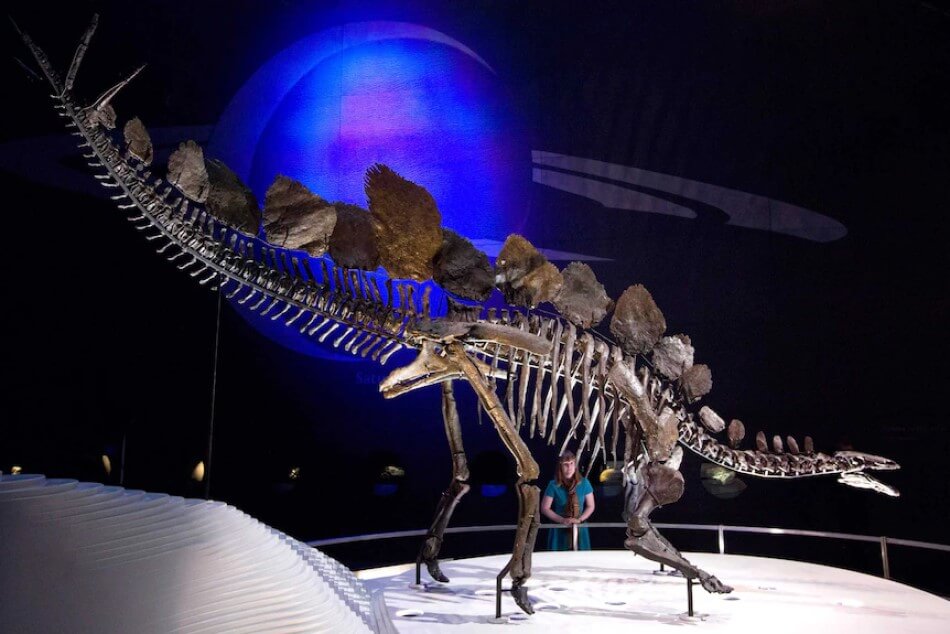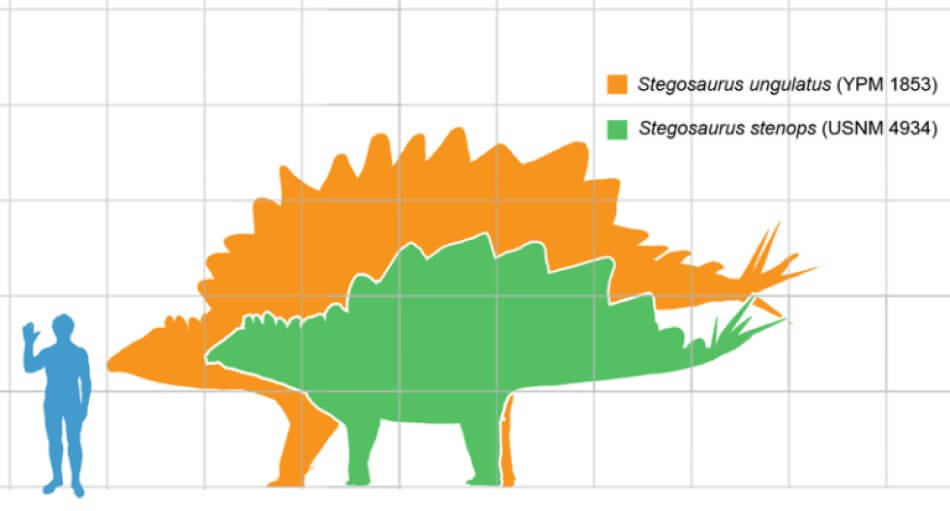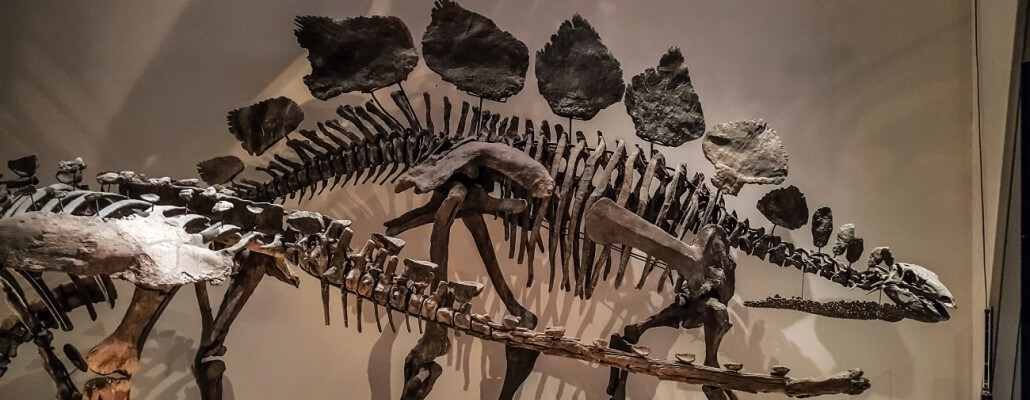The Stegosaurus was one of largest dinosaurs to have walked the face of the Earth. It was a large, plant-eating dinosaur (herbivore) that lived during the late Jurassic Period, roughly 150.8 million years ago. It was about the size of a bus and carried two rows of bony plates along its back, making it appear bigger than it actually was!
This post puts the Stegosaurus in the limelight, highlighting everything we know about these spiky beasts.
1. Stegosaurus essentially translates to ‘roof lizard’.
This comes from the way its back plates were arranged.
2. The Stegosaurus weighed around 10,000 pounds, and was famous for its diamond-shaped plates that were lined up and down its back.
The plates were as large as 2 feet by 2 feet, and it also had 4 sharp spikes on its tail, which were 2 or 3 feet long.
3. The Stegosaurus was a large, slow-moving plant-eater (herbivore).
As such, it was often hunted by meat-eating dinosaurs (carnivorous) such as the tyrannosaurus rex. The Stegosaurus used it’s powerful spikey tail to fend off would be attackers.
4. The bony plates running down the back of the Stegosaurus were embedded within the skin of the dinosaur, and weren’t attached to its skeleton.
This is precisely why most fossils finds have the plates as being separate from the body.
5. The exact use of the plates on the body of the Stegosaurus hasn’t been discovered yet.
While some scientists believe that they might have been used as a mechanism to defend against predators, others are of the belief that it was a means for members belonging to the same species to recognise each other.
6. Tiny grooves were present on the plate surfaces which is presumably where the blood vessels could have been present.
The amount of blood passing through these vessels determine the amount of heat transferred in the body of the Stegosaurus.
7. Despite their size, the Stegosaurus had a small head and brain.
It’s believed that their brain was roughly the size of a walnut. There is also a common misconception that the Stegosaurus had two brains, with the second helping control their mobility. This has since been debunked, no dinosaur had two brains.
8. The most complete Stegosaurus skeleton discovered went on display in the Natural History Museum’s Earth Hall in December 2014.
This was a member of the species Stegosaurus stenops, which is aiding researchers to uncover more facts about the dinosaur. This includes information such as what it might have looked like when it was alive, how it walked, ate as well as its behavioural patterns.

9. Circular lumps were arranged on the underside of the Stegosaurus’ neck.
It’s believed that this helped protect its jugular artery from hungry predators.
10. A noticeable percentage of known Stegosaurus tail spikes have broken and re-healed tips, which indicate they were used for self-defence.
One famous Allosaurus fossil included an unusual hole which as apparently made when the carnivore tangled with a feisty Stegosaurus and its well-armed hind end.

11. The Stegosaurus had quite the gait (the way in which it walked), as its body structure suggests.
It walked on four legs and kept its head low on the ground while its spiked tail waved high in the air.
12. The characteristically arched appearance of the dinosaur was mainly due to shorter front limbs in comparison to the rear ones.
Their feet were short and broad, rendering the dinosaur barely agile and relatively slow.
13. The year 2010 saw palaeontologist Miriam Reichel discovering that the Stegosaurus had a relatively small bite force.
However, their mouths were good at snipping through smaller branches and plants.
14. Although the Stegosaurus was first found in the US, there is a strong indication that it roamed the Portuguese terrain as well.
This would have been around 150 million years ago.
15. Stegosaurus’ usually grew to a length of about 6.5 meters (21 feet).
It’s believed that the largest specimens could grow to around 9 meters (30 feet) long.
16. The Stegosaurus is the state dinosaur of Colorado.
Other state dinosaurs include the Triceratops (Wyoming) and the Hadrosaurus (New Jersey). There are 15 state dinosaurs in total.
17. It’s believed that the Stegosaurus swalled rocks to aid digestion.
Rocks that have been swallowed to aid digestion are called ‘gastroliths’, which essentially means ‘stomach stones’. These stones would tumble around inside of the Stegosaurus’ stomach and help break down the plant matter.
18. The Stegosaurus was first discovered in 1877 by Othniel Charles Marsh.
This was during the Great Dinosaur Rush, also known as the Bone Wars. This was a period of intense and highly competitive fossil hunting, where a fierce rivalry between Othniel Charles Marsh and Edward Drinker Cope pushed them to find as many fossils as possible.
19. Experts believe that the Stegosaurus had cheeks.
This allowed them to thoroughly chew and pre-digest their food before swallowing it, and could pack away more vegetable matter than dinosaurs without cheeks.
20. As the dinosaur was discovered relatively early in paleontological history, it has become the poster-lizard for wacky dinosaur theories.
Early naturalists thought that the dinosaur was bipedal just like the Tyrannosaurus Rex. Some experts argue that the dinosaur may have been capable of the occasional hind foot stand, especially when threatened by predators.
21. It is said that the Stegosaurus’ of the late Jurassic period were cousins of the ankylosaurs.
The ankylosaurs prospered tens of millions of years later, during the middle to the late Cretaceous period.
Any presumptions that might have existed about the Stegosaurus are officially out in the open! These unique creatures might have existed millions of years ago, but the fact that their legacy is still talked about in today’s times is a testament to the impact they left behind.
Stegosaurus Fact-File
| Type | Armoured Dinosaur |
| Length | 9 metres |
| Weight | 3,000 kilograms |
| Diet | Herbivore (plant eater!) |
| Teeth | Beak with small rounded and peg-like teeth. Cheeks for storing more food! |
| Movement | Quadrupedal (walked on four legs) |
| Lived | Late Jurassic period, around 155-145 million years ago |
| Found in | United States of America |
Stegosaurus FAQs
What are some fun facts about the Stegosaurus?
The name Stegosaurus literally means ‘roof lizard’, thanks to its diamond-shaped plates that were lined up and down its back.
How fast could the Stegosaurus run?
Researchers believe that the Stegosaurus was relatively slow, with a maximum speed of around 5 miles per hour (8km per hour). This is because of its short forelimbs in comparison to it’s hind legs. If they ran too fast, they would become very unstable and likely tumble down.
Why is the Stegosaurus the dumbest dinosaur?
The Stegosaurus is considered a dumb dinosaur due to it’s very small brain, which was around the size of a walnut. However, the Stegosaurus thrived for millions of years, fighting off fearsome predators and competing with other herbivorous dinosaurs. As such, it’s likely that it wasn’t as dumb as it’s brain size suggests.
Did the Stegosaurus have teeth?
The Stegosaurus had a beak, and then small teeth within it’s cheeks to help chew it’s food. It’s believed that their jaw could only move up and down, as opposed to the sideways chewing motion cows have today.
What is the tail of a Stegosaurus called?
The spikey tail of a Stegosaurus is called a ‘thagomizer’. It’s tail was likely a defence mechanism, scaring off would-be attackers such as the T-Rex.
